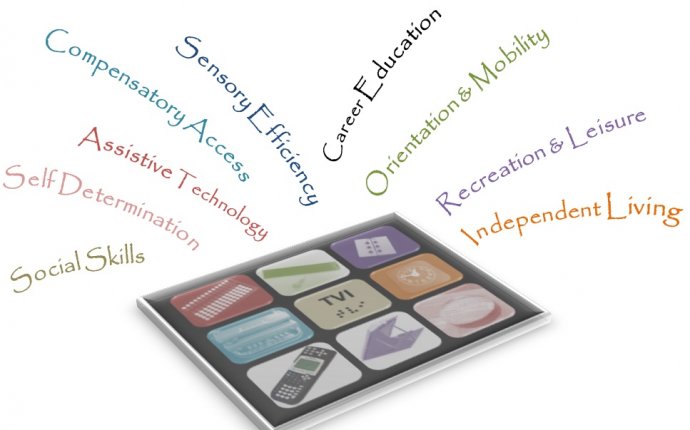
Visual impairment teaching strategies
- It's okay to say "look" and "see." Even fully sighted people use their other senses in the context of looking at something. Visually impaired people might look at things in a different way, but "seeing" is in the perception (rather than the eye) of the beholder.
- Audiovisual presentations and demonstrations are made accessible to severely visually impaired students by providing verbal explanations. Read what is being written on the board and/or describe what is pictured in the presentation. Allow the student time to handle tactually adapted materials.
Saying "over there" and pointing to something the student can't see are not useful with a blind student. Instead, spatial directions must be given from the STUDENT'S perspective. Remember that the student's left and right are opposite yours when you are facing the student. - Seat or encourage the visually impaired student to come to the front of the classroom or presentation area in order to be certain that s/he hears all instruction/explanation correctly.
- Braille materials take an exceptionally long time to order and/or prepare. Textbook committee members should be aware of this and be certain that braille textbooks can be ordered in January for the following fall so that they can be transcribed in time. Extra time may be required for math and technical books, as Braille mathematical notation requires a unique certification that many literary braille transcribers do not possess.
- Classroom handouts, especially those with pictures or diagrams, also require a great deal of time to transcribe into braille and tactile formats or verbal descriptions. Classroom teachers are wise to provide materials to be transcribed at least two weeks ahead of time, preferably on disk, as some text can be transcribed using computer translation software.
- Expect the visually impaired student to complete the same assignments as the rest of the class. Due to alternative media, assignments may take a visually impaired student longer to complete. An average of double time for Braille or tape is a good rule of thumb. Due to time constraints it may occasionally be necessary to reduce the number of examples to be completed for classwork or homework (such as in math problems), as long as the student is able to demonstrate that s/he understands the concepts and/or skills exhibited within each example.
- Independence is of primary importance! Be patient. Observe the student, silently encouraging independent problem-solving skills. Wait until the student asks for help and provide minimal assistance only as needed to build self-confidence and independence.
- Avoid leaving doors and drawers ajar or chairs out from under tables and desks. Either keep furniture consistent or inform and/or involve the student in rearranging.
- Address all students by name so that the visually impaired student can learn to associate names with voices of classmates. Address the visually impaired student by name as well, so he or she knows when he or she is being spoken to.
- Encourage the student's use of proper posture, eye contact as much as possible and proper social etiquette. Discourage any inappropriate mannerisms to maximize the student's physical and emotional health, as well s the student's social, educational and career potential.
- Always treat the visually impaired student equally with other students. This includes discipline and special privileges as well as involvement in extracurricular and leadership opportunities.
- Give the visually impaired student as many opportunities to help others as to be helped by others.
- Please don't presume that just because the student can't see and is using other learning mediums that the student is incapable. Try to allow the student to use their strengths in the areas they have to learn.
- All students, including those with visual impairments, learn at individual rates.
Summary: As much as possible, treat the student the same as any other student and your example will encourage classmates to do the same.
perverted education master of education purpose of education blog in text citation apa blog maker free blogging zones postsecondary education board of education wv considerations before blogging blogging pro jobs difference between blog and forum blogging ring light should i blog or vlog blog post template google docs mn department of education continuing education credits education of donald trump blog inside blogging services education lawyers american council on education google for education blogging goals american education services benjamin netanyahu education blog after effects dave thomas education center education lawyer public health education higher education act of 1965 frontline education sign in frontline education blogging from scratch blog to make money bad education 2004 blogging from home jobs harvard school of education eai education makeup blogging blog kitchen remodel apple education blogging podcast
Source: www.tsbvi.edu








